

You may have noticed late last year the AANA broadened their official definition of “advertising” beyond that of a paid-for message. To reflect the changes the Internet has brought about, they now refer to “marketing communication” activity as brands are now often engaging in two-way conversations, not just pushing messages one-way via ads.
Early this year CommBank’s CMO Andy Lark, an ex PR man himself, told PR agencies they risked losing their traditional area of expertise to digital experts and integrated agencies.
The issue for businesses isn't simply which external supplier or internal staff is running your social media. With new technology comes a lack of control over how customers choose to seek information and engage with you, which brings a new level potential for confusion. And just as there is confusion around whom within a company or it’s preferred communications partners should be in charge of the conversation, the laws we all operate under right now are equally confused.
Who is responsible for comments posted on your business Facebook page?
In response to an ACCC ruling and fine of a liquor brand for leaving comments on it’s Facebook page deemed to he inappropriate, the AANA extended the reach of its Codes to cover most forms of advertising and marketing communication over which the advertiser or marketer has a reasonable degree of control.
In two recent determinations dealing with brand-owned Facebook pages, the Advertising Standards Board (ASB) reflected the AANA’s intent and stated:
“The Board considered that the Facebook site of an advertiser is a marketing communication tool over which the advertiser has a reasonable degree of control and that the site could be considered to draw the attention of a segment of the public to a product in a manner calculated to promote or oppose directly or indirectly that product."
"As a Facebook page can be used to engage with customers, the Board further considered that the Code applies to the content generated by the page creator as well as material or comments posted by users or friends.”
While you may think this ruling is a bit rough, at least you know where you stand. Until this week.
The AANA at least gave clarity, we now have a contradictory new set of guideline by the IAB
“After a careful analysis of existing laws and regulation and industry practice around social media IAB Australia has reached the view that user comments directed towards an organisation or social media platform, or to other users who are drawn to a particular organisation, do not constitute advertising,”
According to Samantha Yorke, director of regulatory affairs at IAB, “There is a real risk that organisations who treat user comments as advertising will err on the side of caution and moderate user comments very conservatively, which will adversely impact their presence on social platforms and which arguably undermines the very spirit under which social media thrives,”
I wonder what a judge will say about a marketer’s immoderate management of a social media campiagn in a yet to be held ACCC hearing?
UNO is one of a small number of marketing communications agencies accredited by The Communications Council of Australia. We believe self regulation only works when all of our customers' messages within our control are held to the same highest standards of paid-for and signed-off ads, irrespective of whether published in a traditional, new or yet to be invented medium. At least that way our clients have minimised their risks, both known and unknown.
Read More
There are many tips and how to guides claiming they have the key to revealing the relative strengths and weaknesses of where to advertise, promote and connect. Media sales reps have a long history of presenting charts and graphs that show their medium in a favourable light. To ensure the best ROI marketing, we only rely on those studies that have rigorous methods and meaningful numbers to make the findings reliable.
Don't trust every media benchmark you can Google
For those who want to know what medium is most effective at acquiring new customers in the digital era, here is a chart we feel is valid:
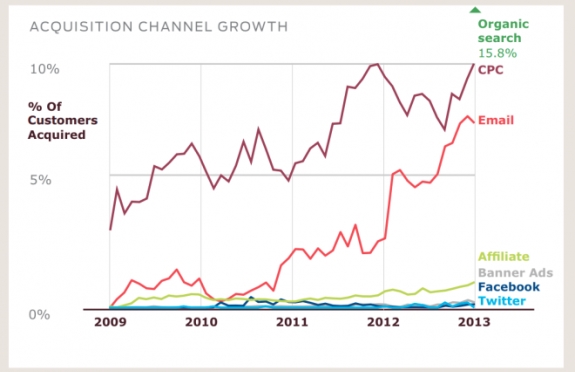
Trend in performance of digital channels for acquiring new customers
Custora came up with these figures by analysing data from 72 million customers shopping on 86 different retailer sites. They tracked where customers were clicking from (email, Twitter, Google, etc.) and what and how much they bought, not just on that visit but for the next two years.
Over those two years, Custora found that customers who came to retailers from search were 50 percent more valuable than average. In other words, they were more likely to shop more and spend more. Email customers were nearly 11 percent more valuable than average. Customers who came through Facebook were just about average. Twitter customers, meanwhile, were 23 percent less valuable than the average during the two years following that first click.
I've written before that our reluctance to spend clients' money on banner ads is based on one amazing fact: you are more likely to win Lotto than click on a banner ad.
In comparison to these digital channels, research by the Direct Marketing Association shows you may still be best served with good old direct mail:
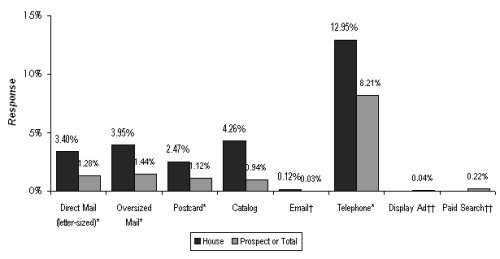
Average response rates for direct sales, DMA 2012
There is one new piece of research though that ultimately makes the discussions about differences between media effectiveness become a secondary consideration. It's proof of what many of us have always suspected.
How you craft your message is more important than the medium
The latest research into advertising effectiveness in Australia has proven creativity makes a big difference. The Association of Data-driven Marketing & Advertising shows that after 12 months ads with better ideas are both more effective and increase a brand's ability to harden pricing.
This reminds us you’re potentially wasting your time and money if you don’t get your pitch right. As consumers we remember big ideas, like “Think small.” Or the pulling power of a well crafted headline like “It’s Time.” Or a picture worth a thousand words...
The truth well told has been proven yet again to be more important in getting the best ROI from your marketing than any optimisation techniques digital specialists may dazzle the bean counters with. We are not animals, we are human, and we respond to emotions, not numbers of targeted exposures.
For those who want to make the most of their investment in airtime/space/or face-to-face, remember to invest a little in the art of communication.
It's not just consumer brands that can benefit from better communication
An ability to express your message is just as impotant for both service businesses and B2B. This is especially true for financial services, as shown by this chart of what customers say are the most important qualities in a financial adviser.
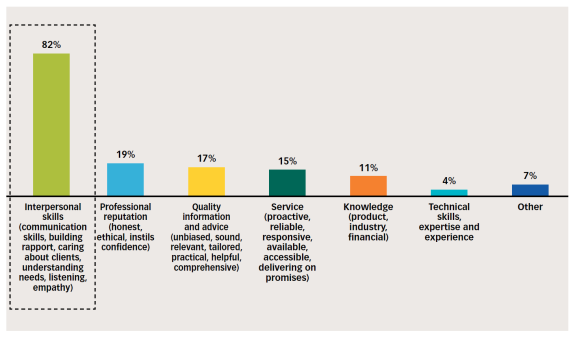
AFA White Paper: The Trusted Adviser May 2013
The report found the biggest difference in success of the top 10% of financial planners and the rest isn’t expertise, or credentials or technology – it’s the ability to communicate. Communication is not talking at people, it's the art of speaking with empathy. This is where social media excels. Use it to listen to your customers, then respond in a way that makes the individual believe you understand where they are coming from.
Irrespective of digital or traditional, face-to-face or in writing, where you have the conversation is secondary to the way you express yourself.
Just remember to make the message suit the medium. Our burping cow ring tone for Sipaah was downloaded by lots of kids who knew exactly where our brand was coming from.
Read MoreFame is the game of the name


The exponential pace of change is increasing the pressure on businesses to stay competitive. You know it’s not going to slow down. Fortunately there are still ways you can take control. One proven method is to revisit some simple building blocks to help make your brand relevant in today’s complex marketplace.
4 step process to make a challenger brand famous:
GAME
NAME
FAME
CLAIM
Game:
When did you last define what it is you do you do that makes you a specialist. In a cluttered business environment it pays to play in a defined niche where you know more about the rules of the game than your competition. Define the things that are of value to your prospect. Make sure you understand what it takes to be world’s best at your game, and work to stay at the top. People will still pay you a premium for something special that means something special to them.
With a fresh outside perspective, define your true differentiators, your “authentic truth.”
Name:
Your reputation, the brand and everything it does must be aligned with what you do that is special or your efforts will be diluted. Today, any business with integrity can compete against established incumbents. The cost of entry is no longer big budget mass media campaigns, the spoils now go to the nimble.
Today, the truth is what counts, the public can find the facts faster than businesses can attempt to shape opinion. Ensure your brand reflects your truth in everything you say and do.
Fame:
The art of being noticed. And remembered. And talked about.. You can do this several ways. Spend a lot of money, like Swisse, who invested up to 60% of annual revenue to marketing to achieve business growth, which stands at about 50% year-on-year over 4 years.
Or take the stand out in the crowd approach. An elevator pitch is only of value if people are listening, be too polite and you will be invisible. There is something to be said for the fart in a lift approach, however can you risk going viral with the wrong tone of voice?
Ideally, you can take the hero approach: be noticed by the right people for the right reasons. To do this ensure you choose the right medium for your message. There have never been so many communications options – a pitfall for the unwary, and an opportunity for the savvy
Claim:
Tell the truth, especially now the customer can search the Internet to discover what is a genuine claim and share with their friends what they find out. Decide what will differentiate you in your game – do you do it faster or smarter, cheaper or better?
Then find a creative way to express your difference. As J Walter Thompson said almost a century ago, “the truth well told” is the value add of great advertising.
Famous campaigns start with a defined customer benefit
What’s your “Which Bank?” How will you enter the vernacular, as this one of mine did 25 years ago:

With a creative leap, you can express the human insight that will resonate with your prospects. And they’ll repeat it to friends, again and again.
Read More

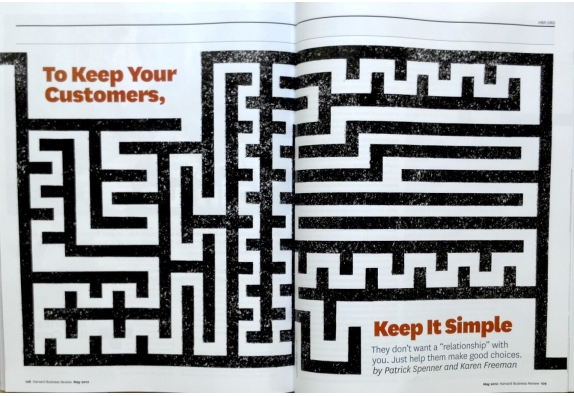
How do you explain to the manager who signs off your budget that today customers want more from your website than a brochure online? You can start by pointing out how you can replace existing fixed and recurrent costs with keener priced digital alternatives. Then remind the cost controller that technology is moving so fast they’ll be surprised how much more you can do today for less. A lot less than many of the savings to be made across existing business practices that digital can now enhance or replace. This 12 point digital checklist can help you keep it simple and the returns substantial.
Your digital project 12 point checklist
Keep an open mind, what the site needs to include is based on what the customer wants, don’t limit scope by prescribing whats to be included by your what your preconcievd ideas of what the competition have already done.
Engage with the user in the context of where and how they are accessing you. Are they on a mobile while in a shop, in bed on a tablet or at their workdesk on a PC? At work, at home, on the move, your site experience needs to change accordingly.
Educate or entertain? Ask yourself are they visiting your site to learn more, or simply because it is an enjoyable experience? Or would they like it if you did both? Deciding this helps shape your content and navigation.
Personalisation. "Allow users to personalise their experience. People love to add personal touches because it helps them feel at home and in control. Provide sensible, beautiful defaults, but also consider fun, optional customisations that don't hinder primary tasks." - Google Android
If you don't treat each customer as an individual, a competitor will. Technology now enables you to serve each visitor exactly what they want, a bespoke site just for them.
Innovate.The digitisation of everything now allows you to reinvent so many of your business functions and methods, take advantage of what is now possible.
Tone of voice is more important than what you say. The way the site looks, the colours used, typography, whether there are pictures or videos and the style of vocabulary you use will make a bigger impression about your brand image than what is in the text.
Services is what you build today, not websites. "Our service doesn’t begin and end at our website. It might start with a search engine and end at the post office. We need to design for that." - GOV.UK
Iterative, our most used word to describe our process for scoping, designing and building a digital service. Start small, constantly evolve and develop the service offer. We learn and improve the offer together as we go.
Marketing. A site without marketing is an island resort that’s not on any map, let alone an itinerary. Don’t launch and leave, have a plan that will drive customers and prospects to your site, align what the promise is and how your site will deliver to expectations.
P, there are 4 of them in marketing: Product, Price, Promotion, Place. Consider which of the Ps is most useful to enable you to best engage with each type of customer. The 4Ps of marketing aren’t all the same for every person or every occasion.
Load time is more important than looking good. Too many fancy things can slow down the experience.
"Make important things fast: Not all actions are equal. Decide what's most important in your app and make it easy to find and fast to use, like the shutter button in a camera, or the pause button in a music player." - Google Android
Effectiveness. Know what you want to achieve and why. Most importantly decide how you will measure with meaningful metrics that can be acted upon. Then you can build in measurement techniques to track what is working and what needs to be improved. And make sure someone is in charge of tracking results and implementing improvements.
If in doubt about what matters most, remember the customer's perspective comes first. Look at the first letter of our 12 points. In an increasingly complex world, when you connect with customers they will appreciate it of you can KEEP IT SIMPLE.
Read MoreRadioactive ads from when people didn't know better

Classic ads from 1910-1930 for radioactive products
What can’t radium cure? A century ago it was legal to advertise radioactive products, from toothpaste to suppositories, condoms and check out the chocolate!

If looks could kill: Radium lipstick advertisement from the 1930s. (via 109.com)

More classic ads from the 1930s for the Tho-Radia range of makeup.

Nil by mouth, guaranteed harmless?!! Gives new meaning to "the ring of confidence"

Anyhow, have a radium.
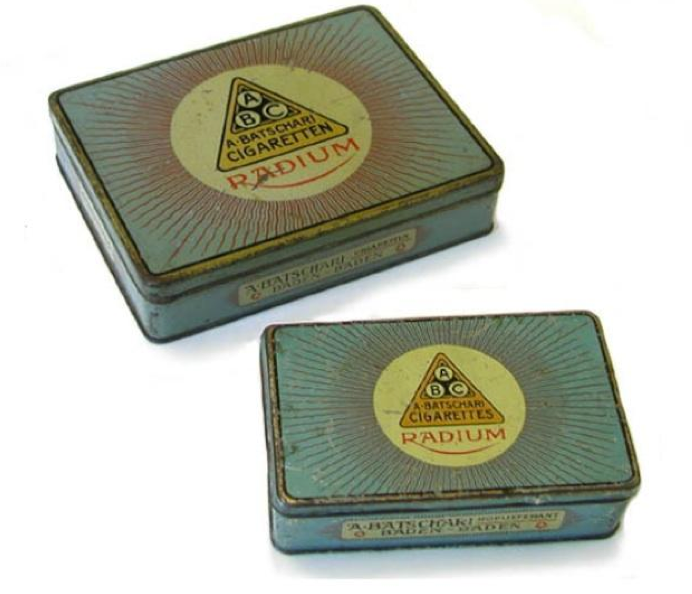
Now in a convenient pocket size pack of 20s. They didn't know smoking kills.

Mrs Marsh could give us a demonstration of the brighter effects on your smile of Radium toothpaste.

Chockaholics aren't left out, Radium is everywhere. The ads claimed eating a block would make you look younger.

Time wasn't on the side of those with radioactive numbered watches that glow in the dark.

Another ad campaign competing for share of the toothpaste that glows market, now with added thorium.

Radioactive wool keeps you warm on the slopes.
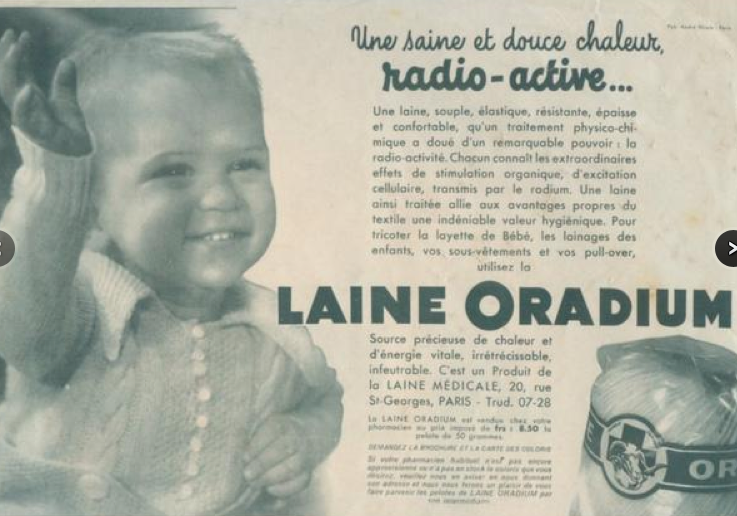
Dress your baby in it.

Advertised as a cure for arthritis, rheumatism, mental illnesses, stomach cancer and impotence. (via Real Food University and Oak Ridge Associated Universities) Triple distilled, who needs a whickey chaser?
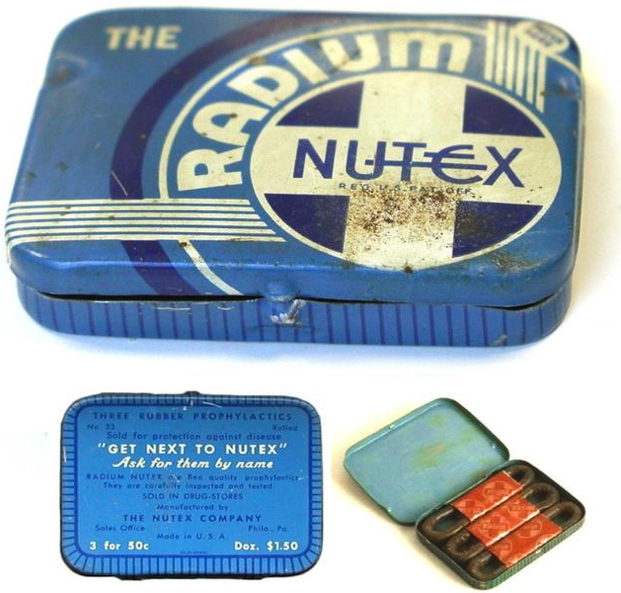
Condoms, that glow in the dark?
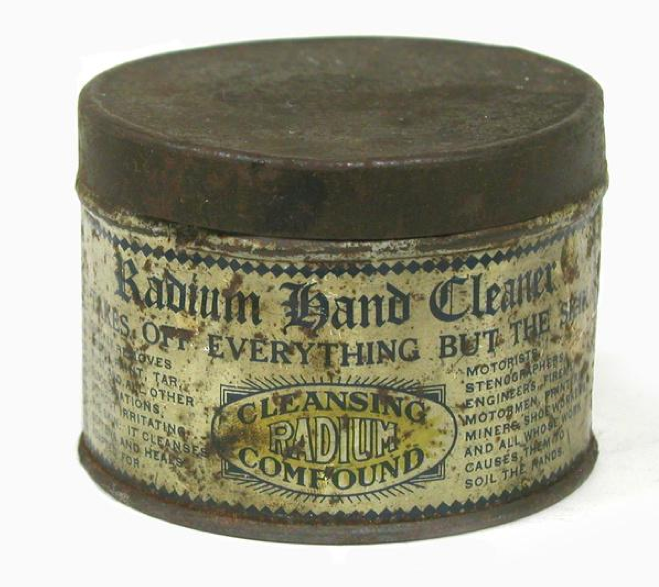
They didn't realise you can't wash off radiation poisoning.

Dr Curie started something big. Cosmetics companies continue to claim they have the secret to eternal youth.
Like to see some more classic ads?
Have a look at 12 great vintage politically incorrect ads for Christmas gifts.
Read More

Everyone knows the way to lose weight is to eat less and exercise more.
Yet year after year most Australians are getting fatter. Fatter people aren’t as healthy. Fatter people die earlier than fitter, leaner people.
A whole industry makes money out of fat. Fitness clubs. Personal trainers. And diets. None of it works over time. The stats prove it. It’s not enough to know you have a problem. Personally I have never been better educated, yet I’ve never been so overweight.
Science has shown only cognitive behavioural therapy ensures long-term positive change and a healthier longer life as an ex-fatty. 21 days of mind reprogramming is just the start to breaking the usual fatso habits.
Business as usual doesn’t work. How long till the business you work for dies?
Australian businesses are fat. They aren’t fit enough to cope with today’s rapid pace of change and increasingly complex issues. They don’t exercise their brainpower by trying something new. And like most of us with a weight issue they are looking for the quick fix. So they outsource it.
The diet industry equivalent in this instance are the service providers, from the Deloitte pre-prepared meal programs and the peddlers of management boot camps, to the efficiency fitness trainers selling the benefits of Sigma 6 and Lean. Even the language is the same as The Biggest Loser.
The answer for struggling businesses isn’t in doing the same things more often, or paying more personal trainers to lift your motivation. Nor is it enough to reduce the excess fat by cutting costs. Stomach stapling the business results in staff suffering reflux, hunger pains and mental stress for no performance improvement.
The answer is cognitive behavioural change.
The answer is developing an innovation mindset.
Here’s how it works and why most businesses are doomed to die early.
It starts with the owners of the business recognising they have a problem. An attitude problem. Their brains have been thinking the same way so long their synapses have turned a well-worn groove into a rut of superhighway proportions. The problem is, it’s now a road to nowhere.
The new business opportunities aren’t where the brain has become accustomed to drive to, every category is seeing their marketplace become a ghost town. Today’s marketplace is somewhere new, and management not only don’t know where it is they don’t have a map to show them how to get there.
The new destination is growing, profitable and exciting. It’s enabled by the Internet and feeds on new ideas made possible by software as a service, unified comms and the cloud. The new place isn’t a city or a country or a category, it’s everywhere and anywhere the customer happens to be, 24/7. Now every customer or prospect can pick and choose what they want via a mobile device. From cat food to cars, retirement plans to restaurants, you can research and purchase without talking to a salesperson.
Yet business owners continue to think the value of their business is existing fixed assets and legacy systems, current supply contracts and distribution arrangements, proprietary processes and procurement systems. Australian managers continue to tweak a little here and there around the edges of their business models. Generally, the bigger the organisation the more cholesterol blocked the arteries of internal management and external communication.
Figuratively speaking, fat dead men walking the corridors of offices around the country are about to be knocked off by fit and nimble female and new age male entrepreneurial thinkers who are open source and open minded.
So what do our business leaders do? They buy another diet book, like the biography of Steve Jobs. What they don’t realise is reading about Apple is as relevant to middle managers as middle aged men reading about Usain Bolt’s exercise regime. Apple was a challenger brand from day one. It was in the DNA.
The answer isn’t reading a book on what someone else has done. It comes from doing what hasn’t been done. It comes from the confidence to try something new with a willingness to fail. Accepting you’re likely to fail again and again. Because continuing to do what you do now is guaranteed to fail. While with every new thing you try your chances of discovering a winner increases.
Changing your habits and practicing to do what doesn’t come naturally, every day, is the proven method for success. It’s making a habit of taking small risks often so you don’t stand still and become another Kodak. The proof is in understanding how Fujifilm could innovate itself a future as a cosmetics company.
Memories might be priceless, they just don’t make money like they used to.

How a traditional business became a challenger brand
Fifteen years ago Kodak entered a death spiral, from a global peak in 2000, camera film sales dropped 90 per cent in 10 years as the digital revolution swept the world. “We’d known it was coming since the 1980s,” says Yojiro Yamashita, general manager of Fujifilm’s life science products division.
Kodak didn’t make it, going bankrupt last year. Fujifilm not only survived but emerged into the digital world of today with a series of innovative new businesses.
Fuji recognised what its’ true strengths were says Tomoyuki Yamazumi, a cosmetics industry analyst for the research firm Fuji-Keizai. “It had the financial power plus a strong marketing ability and existing ties to consumers.” One of the small risks Fuji management took was launching a cosmetics range in 2007. By 2010, sales of Fuji’s upmarket Astalift brand were already over $100million a year. By 2018 the company is looking to increase skincare and supplement sales by ten times that.
Look around your business. Are you a Kodak, or can you recognise your strengths, try something new and innovate your way to a future as a challenger brand?
This article first appeared in AdNews, 30/5/13
Read More

At CeBit 2013, Salesforce Vice President Vivek Kundra’s big question for Australian leaders is “how can a country of 22 million people compete in a world of seven billion?” His answer?
“It’s not about size. It’s going to be about innovation. Innovation policy and an innovation agenda have to bethe come building blocks of a nation that’s going to compete in the global economy.”
Third wave of computing is changing the global economy
Competition in the global world of business is being driven by a ‘third wave of computing’. Essentially the shift from hardware to cloud based software and services and super fast mobile broadband networks that allow consumers and workers to access data on portable devices. Our clients have seen a doubling of visits to their websites from mobile devices over the last year. In fact, this year more people globally will access the Internet from a mobile than a computer.
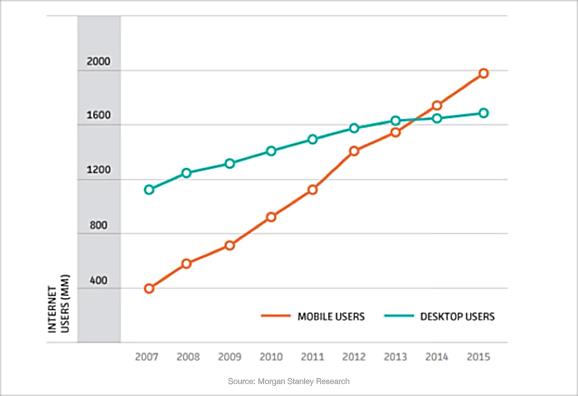
The opportunity for challenger brands
The biggest risk for businesses I’ve observed are the internal stakeholders defending their hard fought for legacy systems and infrastructure, and managers who are obsessed with efficiency through fine-tuning traditional methods. As Kundra points out, competitiveness now comes from letting go of what you’ve currently got now. “Most large scale organisations are still stuck in 1980s technologies. If you’re still stuck in an old mindset then unfortunately there’s a young entrepreneur who is imagining the way the world should be rather than it is.”
“The most amazing opportunities lie in reinventing entire sectors of the economy.” Vivek used the usual examples of US companies like Amazon, Netflix and Uber as businesses that are challenging categories today.
If you are running a business you have a clear choice he says – “do you want to be Amazon or Barnes & Noble?” This isn’t a particularly new view, as a global survey by Boston consulting summed up a couple of years ago, in this world of rapid change the spoils go to the nimble. Still, many managers still don’t seem to be responding.
“There’s a Darwinian spirit to the extinction of those who are holding onto the 1960s ways of doing business.” Vivek states, “not because it’s in the interest of the customer but because it’s easy and it’s because that’s what they know what to do.”
A marketer’s mantra for today: “The customer. The customer. The customer”
This is the biggest differentiator for challenger brands. “Companies that are embracing the third wave of doing business are doing it in the interest of the customer.”
Kundra recognises the fear of change within businesses when he suggests the best way to introduce a change culture is to build a prototype. “I think for too many people the expectations for transformative technologies is that it takes too long, costs too much and they’ve been burned in the past.”
A test and learn approach reduces risk
Last week at the launch of an AGSM Mid-Market program a professor specialising in innovation for business pointed out success today comes from having a portfolio of new initiatives that can be tested quickly in the marketplace. Rather than over researching only one strategy in an attempt to minimise risk, be willing to fail and fail frequently. The chances of some prototypes being winners with the customer will increase the more you try.
As Kundra says, aim to “be relevant and simplify the customers’ or citizens’ lives”.
Read More

The latest statistics on online fashion retail sales, research on the main purchase driver for financial advice and a Californian think tank pricing model all give marketers strong reasons to reconsider Price as a useful tool.
Evidence 1: Online fashion sales prove price not the motivator
No wonder Australian retailers are scared of online stores. British online retailer ASOS recently revealed that Australia is its single largest foreign market — with Australians buying something from the ASOS website every 6 seconds. The latest research from Roy Morgan shows at December 2012, 7.6% of Aussies aged 14+ (or 1,430,000 people) had made an online fashion purchase in any given four weeks — up from 5.7% (1,062,000) one year earlier.
Online fashion-purchasing habits by Australian women by sub-category, 2011-2012
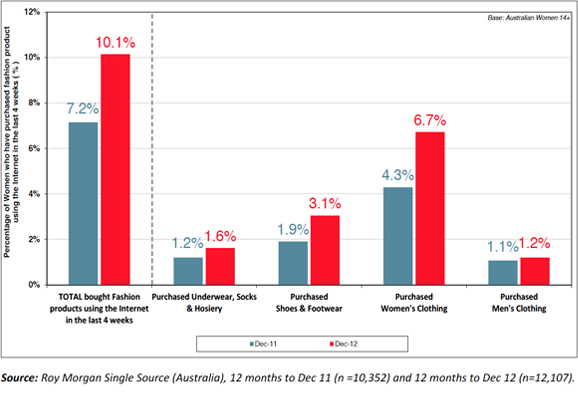
What is really interesting is the opportunities for marketers this research reveals. Most people would probably jump to the conclusion that these online sales are being lost by Australian stores because clothes are available cheaper from overseas. Everything on the web is cheaper, right? Well actually, no.
Roy Morgan’s research has found “scoring a bargain is not the main motivation for women purchasing fashion products online. Far more important is quality, with 75% of them agreeing with the statement ‘I believe quality is more important than price’.”
Discretionary spending by women on clothes has parallels with the way men seek financial advice. A recent national survey by an independent network of financial advisors found the vast majority of customers were more concerned about the quality of service and the frequency of face-to-face time they received than the size of the fee. Of hundreds of customers surveyed, price was rarely mentioned. Value was the primary concern, and the value equation was grounded in the perception of the quality of advice. .
None of this is new. I’ve been segmenting customers using the New Economic Order for nearly two decades since it was first developed by two Australian academics.
Evidence 2: choose who you want to be your customer
You can segment the population by three distinct sets which allow marketers to predict discretionary spending behaviour. The biggest segment, the Traditionals, sre generally cash poor with most of their spending accounted for with essential services, utilities bills, rent, transport and food. They have neither the capacity nor the predisposition to purchase discretionary items.
The other half has a common mindset, they share a desire to buy quality goods and experiences. This group is divided in half by their capacity to spend, one half are NEOs, and while they are only a quarter of the population they represent half all discretionary spending. Transitionals are NEOs on a limited budget: a career couple with one at home with a baby, or a high achiever that's just started their own business, or perhaps they have retired.
For 50% of consumers, the Traditionals, a cheap price is their opening and closing consideration. However these are the people who don’t spend much. They also deliver no sense of loyalty and don’t refer new customers. Every sale to a Traditional is a new sale that starts from scratch. And risks going to the lowest priced competitor on the day.
Most restaurant and airline customers and B2B purchasers are NEOs. These people research purchase decisions on the basis of what they believe are the features and benefits that mean the most to them. Price comes LAST, and isn’t much of a deal breaker.
Those latest stats on online fashion sales make sense in light of NEO behaviour. NEOs are online researching what’s hot in the world of fashion. In fact, it’s where they do most research when considering any major purchase because it’s where they control the levers, avoiding the unsavoury hassle of being sold by a salesman face to face. While Traditionals continue to spend the majority of their clothing budget on essential items like socks and undies in stores when the sales are on, NEOs continue to buy more discretionary fashion items, more often, both from the Internet and instore.
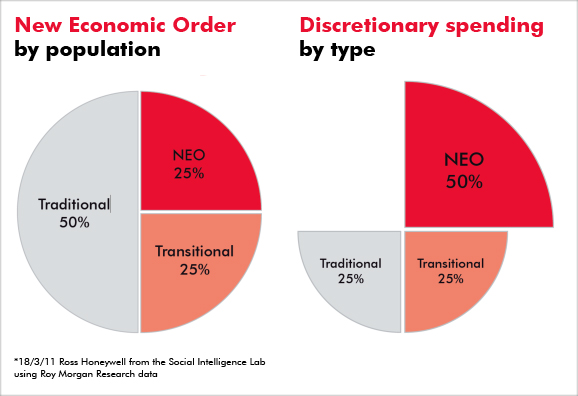
So what’s the best marketing model for selling to NEOs?
Evidence 3: all value is subjective
According to Ron Baker, the founder of Californian think tank the VeraSage Institute there are two fundamental approaches to pricing:
Cost-Plus Pricing
Labour Theory of Value
Product » Cost » Price » Value » Customers
Pricing On Purpose
Subjective Theory of Value
Customers » Value » Price » Cost » Product
You can see how subjective value pricing turns the order of cost-plus pricing on its head, by starting with the ultimate arbiter of value – the customer. In Baker’s words: “Goods and services do not magically become more valuable as they move through the factory and have costs allocated to them by cost accountants. The costs do not determine the price, let alone the value. It is precisely the opposite; that is, the price determines the costs that can be profitably invested in to make a product desirable for the customer, at an acceptable profit for the seller.”
As a marketer, for decades I found software one of the simplest products to approach from the Pricing On Purpose model; it’s the only reason Microsoft had education, standard and professional versions. The mid range product best reflects a fair margin for the cost of production of the product. The same product is then also sold at a low entry price with a few features turned off to maximise sales volume at the low end and repackaged in a fancy big box with a few extra features to maximise margin at the upper end of the market.
Choose who you want your customer to be, only then pick a marketing P
Whether you are selling clothes or cars, fair trade coffee or boutique wine, building materials or investment services, remember when your sales force wants you to discount, ask them to stop and think about the customer. Are you selling a basic product to a student, an authentic experience to a Transitional or a professional service to a NEO? Agree with sales who your customers are before you decide to use the PRICE lever.
Depending on who your customer is, Product, Place or Promotion may be more valuable to them than Price.
Read More

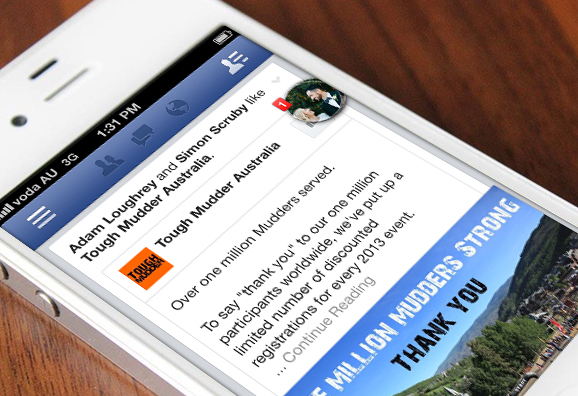
Just being active on Facebook isn’t enough. As with any communications medium, there are smart ways to achieve more for less effort.
Don’t be baffled by social media marketing spin doctors. Sure, Facebook has it’s own set of best practices. Hopefully by getting to know what matters and what doesn’t you can ensure any supplier will make the most of your investment.
The key to making the most of Facebook for your business is understanding it’s all about making sure everything you do improves your chances of being seen.
Much of this isn’t about paying for black art, it’s about basic step by step craft.
40% of time on Facebook is spent on news feeds
Only 12% is spent on profile or brand pages. So:
- Post articles on other people’s pagesPost on less pages more often
- Choose pages with high numbers of fansPhotos have higher ranking than links or text
- Use images
- Keep your text posts short – between 100 to 250 characters get 60% more engagement
- Ask a question
- Post daily and frequently
- Post about relevant topics – don’t push the brand
- Test your audience for their engagement times – 18-24 year olds are most active 9pm – 10pm, women 25-45 even later
How edge-ranking works is the key for marketers
All of these individual steps are only important because of something called edge-ranking. This makes or breaks social media marketing. This infographic shows how it works.
Read MoreThe health checklist for your sales process

15 questions to help your business determine the focus for your sales activity.
Do you have a sales department? Here are 15 questions to help change your sales force from sales takers to sales makers:
- How much time are you investing in new business a day?
- Is the total revenue and the sum of your clients’ budgets growing more slowly than in the past?
- Will growth levels come from present client budgets?
- Where will growth come from?
More frequency of purchase
More volume of each sale
More value? Up sell/or cross sell? - Will growth have to come from new business won from competitors?
- How do you sell to prospective clients?
- What’s your process?
- How do you find them?
- How do you win them?
- How do you prioritise sales calls?
- How is a sales call pre-qualified, (telesales/email/CRM)
- How long is spent face to face?
- What is your conversion rate?
- Is the sales call to the final decision maker?
- Who is the primary decision maker, how are they managed?
ROI marketing can help improve the performance of any of these sales metrics.
Marketing can speed sales, pre-qualify and build loyalty once you’ve made a sale.
In the past business owners were frustrated by an inability to measure what worked and what didn’t. Today there are tools and technques to enable you to measure the return on your marketing investment.
Read More
Here are the stats that show why banner ads deliver the lowest ROI in the digital marketing mix.
- Over 5.3 trillion display ads were served to U.S. users last year. (ComScore)
- That’s 1 trillion more than 2009. (ComScore)
- The typical Internet user is served 1,707 banner ads per month. (Comscore)
- Click-through rates are .1 percent. (DoubleClick)
- The 468 x 60 banner has a .04 percent click rate. (DoubleClick)
- An estimated 31 percent of ad impressions can’t be viewed by users. (Comscore)
- The display advertising Lumascape has 318 logos. (Luma Partners)
- 8 percent of Internet users account for 85 percent of clicks. (ComScore)
- Up to 50 percent of clicks on mobile banner ads are accidental. (GoldSpot Media)
- Mobile CPMs are 75 cents. (Kleiner Perkins)
- You’re 471 times more likely to survive a plane crash than click a banner ad. (Solve Media)
- 15 percent of people trust banner ads completely or somewhat, compared to 29 percent for TV ads. (eMarketer)
- 34 percent don’t trust banner ads at all or much, compared to 26 percent for magazine ads. (eMarketer)
- 25-34-year olds see 2,094 banner ads per month. (ComScore)
- 445 different advertisers delivered more than a billion banner ads in 2012. (ComScore)
Put simply, banner ads don't work
Remember these figures next time a media sales rep tries to sell you a banner ad campaign. Even if it’s free it may not be worth the effort, you’re 31 times more likely to win Lotto.
Read More
The A to Z of digital acronyms


Every industry has its acronyms. With this list you will be prepared when dealing with people who speak digital:
AIDA - Attention, Interest, Desire, Action
AJAX - Asynchronous Javascript and XML
API - Application program interface
AOV - Average order value
AR - Augmented reality
ASP - Application service provider
ATD - Agency trading desk
B2B - Business to business
B2C - Business to consumer
CIO- Chief information officer
CLV - Customer lifetime value
CMS - Content management system
CPA - Cost per acquisition / action
CPC - Cost per click
CPL - Cost per lead
CPM - Cost per thousand
CPV - Cost per view (see also PPV)
CR - Conversion rate
CRM - Customer relationship management
CRO - Conversion rate optimisation
CSS - Cascading style sheets
CTA - Call to action
CTR - Click-through rate
CX - Customer experience
DM - Direct mail (or 'Direct message', in Twitter circles)
DMP - Data management platform
DNS - Domain name system
DR - Direct response
DSP - Demand-side platform
ECPM - Effective CPM
EPC - Earnings per click
EPM - Earnings per thousand
ESP - Email service provider
FAQs - Frequently asked questions
FB - Facebook
FBML - Facebook Markup Language
FTP - File transfer protocol
GA - Google Analytics
HIPPO - Highest paid person's opinion
HTML – Hyper Text Markup Language
HTTP - Hyper Text Transfer Protocol
HTTPS - Hyper Text Transfer Protocol Secure
IM - Instant Messaging
IMAP - Internet Message Access Protocol
IP - Intellectual property (or 'Internet Protocol')
IPTV - Internet protocol television
ISP - Internet service provider
KPI - Key performance indicator
LTV - Lifetime value
MoM - Month on month
MLM - Multi-level marketing
MVT - Multivariate testing
OEM - Original equipment manufacturer
OS - Operating system (sometimes this is used for 'open source')
PHP - PHP Hypertext Preprocessor
POP- Point of purchase
POS - Point of sale
PPC - Pay per click
PPL - Pay per lead
PPV - Pay per view
PR – Page rank
PV – Page views
QA - Quality assurance
QR Code - Quick response code
QS - Quality score
RFI - Request for information
RFP - Request for proposal
ROI - Return on investment
RON - Run of network
ROR - Ruby on Rails
ROS - Run of site
RSS - Really Simple Syndication
RT - Retweet
RTB - Real time bidding
RTD - Real time data
S2S - Server to server
SaaS - Software as a service
SEM - Search engine marketing
SEO - Search engine optimisation
SERP - Search engine results page
SLA - Service level agreement
SM - Social media
SME - Small / medium enterprise. (aka SMB = ‘business’)
SMM - Social media marketing
SMO - Social media optimisation
SMP - Social media platform
SMS - Short message service
SOV - Share of voice
SOW - Statement of work
SSL - Secure Sockets Layer
SSP - Supply-side platform
SWOT - Strengths, weaknesses, opportunities, threats
TLD - Top level domain
TOS - Terms of service
UCD - User-centric design
UI - User interface
UGC - User-generated content
URL - Uniform resource locator
USP - Unique selling proposition
UV - Unique visitor
UX - User experience
VOD - Video on demand
VM - Viral marketing
WC – Week commencing
WOMM - Word of mouth marketing
WYSIWYG - What you see is what you get
YOY - Year on year
YTD - Year to date
XML - Extensible Markup Language
I'm sure we've missed a few. Feel free to add your favourites in the comment box.
Where would you advertise if it was YOUR money?

I read recently, most entrepreneurs who are successful focus on realising their business concepts as well and as fast as they can. Worrying about how much money they will make comes a distant second.
Entrepreneurs focus on what the customer needs. The financial rewards follow if they have developed something that truly creates added value for their customers.
The advice industry is different. Advisors focus on what the customer will pay. Financial advisors charge you a percentage of what you have to invest. Not according to how they add value at the end of the financial year, which is what you actually need.
Last year the ASIC mystery shop of 64 financial advisors found only 2 gave “good” advice. 62 gave generic or bad advice, generally in line with their own interests, not the customers. While there’s no regulator doing mystery shopping of ad agencies or media shops, I suspect marketing services “advisors” wouldn’t score much better.
Digital media is commission driven
Media sales is still predominantly based on a cut of what you spend, not a share of your return on investment. Online ad-sales is the same model, just with a bigger margin from your spend. Some online adspace aggregators mark up inventory by 60%. For a 60% markup their computer serving of your ads has very little value add, let alone quality control. Look at this as an example of inappropriate adexchange placement – an ad for the Maquarie Graduate School of Management targeting women:

Every medium is out to convince you that their category is the best way to spend your money. They will always have a pie chart to prove it. It’s in their interest to have you spend more of your marketing pie with them. This will increase their commission, irrespective of whether it will increase your return.
For instance, Google Adwords looks a cheap way to buy eyeballs. But if your Adwords campaigner gets into a bidding war for the most popular keywords, you’ll spend more than the same number of leads from less popular search terms. Does the supplier care?
You might think the answer is to use media specialists who charge by time. Like lawyers, they’ll make more the longer their process drags on. More meetings, less decisions, the bigger your bill.
There are now more types of specialists than ever, each fighting for a bigger share of your budget – SEO, PPC, SEM, online content, online ads, email lists, data analysts, mobile, apps, ambient, ambush, experiential, waterproof stickers on urinals…
Which mediums are actually best for your business challenge?
I recommend looking at where to spend a clients’ money from this perspective:
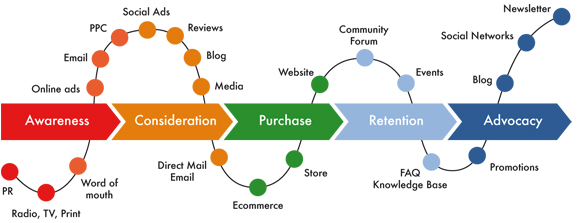
Synergy comes from the right mix, at the right time, with the right creative message. Beware commission driven specialists selling one solution to solve every problem. You’ll get less than you pay for.
Glenn Mabbott
Creative Director & Principal
UNOmarcomms
This article first appeared in AdNews
Read MoreSurvey reveals SMEs fail to measure ROI of online ads
A Yellow Pages survey of 1,800 Australian business owners* has found 69% of small and medium enterprises don’t measure the return on their online ad spend. What’s really surprising in this era of accountability is the finding that only one in 10 base their decisions on where to advertise on the ROI delivered.
What amazes me is the disconnect between business owners increasing desire to do more with less and the missed opportunities these findings reveal.
Advertisers keep telling me they love advertising online because it’s so much cheaper than traditional media. It might be cheaper to buy an adword campaign than a press ad, but are they getting a better return from those clicks?
Do you know which half of your advertising works?
The age-old saying “I know only half my advertising works, if only I knew which half” is just as true of online ad spending as off. The good news is it’s much easier to measure ROI of online marketing than the kinds of activities you used in the past. New technology makes it possible to know what works online and why. Business Intelligence means your spending can truly become an investment with predictable returns.
So if you count yourself amongst the majority of SMEs that don’t have a digital business strategy, maybe you should make it a priority to develop one. After all, there aren’t many things you can do so quickly and effectively that will leave the majority of your competitors behind.
How to measure your marketing ROI
New technologies have also made it much easier to track the performance of your offline advertising and promotion activities. We recently completed another test market campaign for an FMCG customer. In the past it was only major brands that could afford to put in place the kinds of tools needed to measure the ROI of integrated campaigns. Today even challenger brands can track the performance of programs that largely use traditional media because online research, scan data, real time field force reporting and analytics tools are no longer cost prohibitive.
The test and learn approach we have taken with this brand over the last few years has helped lift them above the pack. From being one of half a dozen small players competing for share against a long established multinational, our client is now a clear number 2 in their category. Do you know how much of your marcomms budget is working? There are no excuses because now you can.
* Survey published December 2010


"There are known knowns; there are things we know we know.
We also know there are known unknowns; that is to say, we know there are some things we do not know.
But there are also unknown unknowns – the ones we don’t know we don’t know."
While you may not like his politics, this famous quote from Donald Rumsfeld preceding the US invasion of Iraq perfectly sums up the dilemma faced by business owners today.
People are punch drunk from 5 years of relentless financial destruction of the world’s capital markets. Meanwhile, technology, and especially the digitisation of the world, has seen the pace of change of commerce reach incomprehensible pace. Is it any wonder business managers are floundering?
Challenger brands are making the most of this time of change to gain an advantage over competitors
Many business owners still think they can wait things out until things return to “normal.” What they don't know is the new model for success demands the ability to try new things, quickly and often.
Renee Todres heads a team of digital specialists at Tipping Point that have been helping businesses transform often complex transactions with their customers into simple ones. From BT to Elle Bache, once complicated business processes are being replaced with simple, intuitive interactions that make customers feel in control. Renee makes a wonderful observation –
"to learn you need to listen to yourself less."
Tipping Points approach is to add value by finding new insights. One way to succeed today is to recognise the limitations of your known knowns. Then seek out specialists that can help you discover the unknown unknowns. Get to know the ones that can help improve your position against your competition. And have the confidence to act on those new insights knowing the biggest threat to businesses today is business as usual. The Aussie attitude that she’ll be right now almost certainly guarantees failure.
I'm not suggesting spending all your energies on research. We’ve all seen managers fall into the paralysis by over-analysis trap. Too much data can actually hinder making effective business decisions. According to IBM’s 2012 global survey of 1700 CEOs, asking customers what matters to them is now more useful than financial analysis.
"Of course we need information and insight, but what we need most is the capability to act on it."
Unit head, Government, Hong Kong
In the words of Boston Consulting, today in business “the spoils go to the nimble.” We have found our challenger brand clients are winning by trying new and interesting things, fast and often. In the past you needed big budgets and big balls to try something different. There are now technologies that allow marketers to test new strategies while limiting financial risks.
As Renee and other niche specialists have shown me, it’s surprising how much there is to know that the big brands don’t, simply because they aren't looking.
Read MoreAll those for firing the Marketing Managers? Any against?


When they leave the office for the holidays, many marketing managers won’t realise their role may be restructured out of existence in the New Year. Over the Christmas break, CEOs around the country will be re-appraising who is an expendable cost to the business, versus who is an income generator.
Who will defend so many marketing managers when the case that has been building against them throughout 2012 is so strong?
Here is my snapshot of some of the evidence CEOs may be considering as they weigh up whether to fire their marketing managers:
Evidence A
Many of the tasks that CEOs thought only marketing managers could do can now be Googled. From 99 Designs to freelancer.com any CEO can buy marketing stuff cheap. Whether it’s designing websites or mailers, SEO or adwords, printing or promotions, everything is just a keyword search away. Who cares if you don’t know which half of your advertising works now you can buy it direct at third world prices?
Evidence B
According to this year's Roy Morgan annual professions ranking, marketers have failed again to rise much above used car salesmen. What CEO wants someone with less credibility than a real estate agent on their team? Consider this evidence alongside the growth in Australia of the casual workforce and outsourcing generally.
If you must have a marketing manager, why not buy by the hour, save on fixed and overhead costs.
Evidence C
CEOs have never believed marketers anyway. Fornaise regional survey of CEOs in 2011 found 75% did not value marketing managers opinions at a board level. In July this year the number had increased to 80%.
In November a follow up survey found seven in 10 CEOs hold themselves "somewhat responsible" for marketers’ poor perceived business performance because they have given up on holding their marketing managers accountable. CEOs gave up measuring the performance of their marketing managers. If it isn’t measurable, it won’t be long before the accountants decide marketing managers are an expensive indulgence a lean 21st century business can do without.
Evidence D
Business confidence is at it’s lowest level for four years. More companies went out of business in Australia in the last quarter than any other.
"She’ll be right" is now more wrong than ever. CEOs will have to change the way their business operates to survive. If they don’t know what marketing managers do, it’s an easy place for them to start cutting. As AdNews reported, one recruiter said recently, “companies want to hire revenue generators, and see marketers as passengers not drivers.“
Evidence E
How many CEOs actually know what marketing is? Consider one of the 4 Ps of marketing, price. In the FMCG industry, paying a rebate to Woolworths for a price promotion is still considered a marketing investment, not the sales tool it is.
Evidence F
Consider the other 3 Ps as they apply to businesses today. When do CEOs involve marketing managers in product development, or distribution innovation, or the building of a Business Intelligence driven CRM program? These new silos now fall under Strategy and Innovation Manager or the Supply Chain and Technology Integration Manager or the Chief Information Officer.
Is there a case for marketing managers?
The evidence doesn’t look good if the CEO doesn’t realise marketing managers can add value by thinking across silos. enabling the parts to work in synergy.
The Fornaise study found CEOs “think marketers have continuously failed to unquestionably and consistently prove in the boardroom that their marketing strategies, activities and campaigns generated actual business growth.”
To grow today you have to become a successful challenger brand. To be relevant today marketers have to champion at the board level the power of marketing to create a challenger brand.
If marketers aren’t in the boardroom, either the accountants, the salesmen, even the IT department will contend they need more of the budget to grow the business. Why not take it from the marketing pot, it’s just an artsy fartsy waste of money after all? Isn’t it?
12 days of vintage Christmas ads

Have you heard about the uproar surrounding the latest 'sexist' Christmas ad for ASDA in the UK? Here's your chance in case you missed it.
It seems that history is repeating? Here's a fun look at UNO's 12 days of vintage Christmas ads. They certainly gave us a few laughs!
On the 1st day: What more could a girl ask for?!

On the 2nd day: Should you be tempted to over indulge...

On the 3rd day: What could it be?

On the 4th day: It's the thought that counts!

On the 5th day: The perfect stocking filler!

On the 6th day: Foam filled fun for all the family!

On the 7th day: Taking care of Christmas!

On the 8th day: A shame they didn't make them for dogs too?

On the 9th day: Say it with... spoons?
On the 10th day: We all know that Santa wears red and white because...
On the 11th day: We're sure ASDA would approve!

On the 12th day: Relax in the comfort of your own home
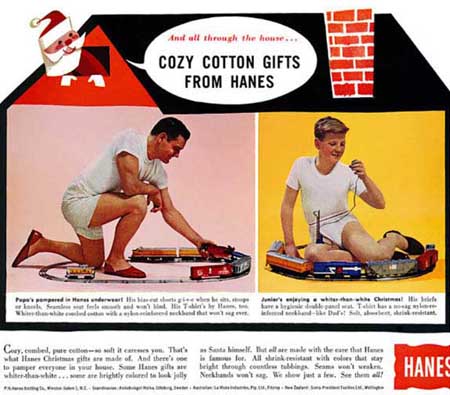
Oh what the heck! One more!
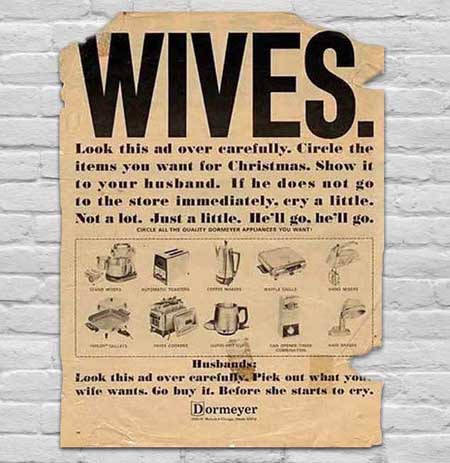
Big businesses' loss can be your gain


In the last few weeks business owners have been warned by the head of one of Australia’s biggest mining corporations that if we don’t change our business models we will die.
So who do business owners turn to for advice? In AdNews the marketing head of one of the big 4 banks reveals agencies don’t get digital. And the CEO of one of the biggest media planners in the country said "anyone in the media industry who claims they know what is happening is lying."
How many consultants does it take to change a light bulb?
Too late, fibre optics and LEDs have changed the market.
Every manager who has grown a business understands the value of seeking advice from specialists, you can’t be an expert at everything. Today we have the added problem that most so-called experts learnt their skills pre-Internet. Most business coaches are dinosaurs, as the world of commerce changes at ever increasing pace, conventional methods won’t save your business if the customer has evolved to a new way of life.
Think biz is tough? It’s even tougher for big businesses
Don’t panic. Unless you are number 1 in your category, you have less to lose by changing the way you play to fit in with the new rules that are being written by the customer. If you are a mid sized business today you have an advantage that in the past was a handicap. Yes, smaller is more nimble. Big businesses with big investments in infrastructure, systems and sunk costs can’t easily re-invent themselves. Think of all those silos of managers in big companies who have to hang in there for another 5 years because their super was decimated. They are a dead weight that slows down change.
Companies falling out of the top 3 in a given year:

Market share leaders that are the profitability leaders:

Forget the past, where’s the future profit coming from?
Most likely from something you are good at now, but not focused on. If you are a mid market player and still in business, you obviously have enough retained knowledge to draw on. Here are some examples of where UNO's clients have found profit opportunities:
- For a manufacturer it was cutting out the wholesalers.
- For a premium winemaker it is leaving Coles and Woollies to the major brands and growing high margin club membership.
- For a financial services B2B supplier it is repackaging bite-sized insights for the consumer market.
Today more than ever, get to know those who know
What you most need now is a trusted advisor who can draw upon a network of today’s specialists. To grow today, you need to re-invent your model, refresh your offer and relaunch by integrating traditional and new ways to market.
Forget incremental improvements. A few percent saved on input costs and a couple more from efficiency gains won’t save you when the competition pockets a whopping 30%+ of margin by removing an entire step in the route to market.
There’s an idea. Better to do it now, or be done over?
For a better career, get a life as a sponge


Many people in marketing seem to think they are judged on what they will do this week, while many managers think it’s about avoiding mistakes by doing very little. Rather than worry about what others may think of your actions/inactions in the short term, a recent conversation with a self-made squillionare reminded me of what it takes to become successful in business life. It’s not about you – soak up other people’s experiences.
Curiosity is the key
This founder of many businesses was as keen to ask questions about my challenges, as I was to learn about his successes.
Creative people continue to take the passive role of waiting for a brief, hoping the application of their current skills to their next project will bring the recognition they deserve. Meanwhile marketing managers act like thought police, determined to minimise all risks on their watch. So the brief ends up something like this: do something safe, measurable (as in lets make sure there are no nasty surprises), something a bit like someone else has already done, and all for less than it cost last time. This lack of desire to explore the unknown is killing creativity in Australia. Yet it’s creativity that builds wealth. Avoiding risk guarantees smaller returns, or none at all. Cutting margins does not create wealth, it just means you’ll spend your way to mediocrity a bit slower.
Today for a business to thrive it has to be a challenger brand. That’s an old company doing things in a different way, or a new one doing new and interesting things. Being a challenger is not about fine-tuning or polishing what you’ve always done. A business that’s in a well-worn smooth groove, just like a career, soon discovers it’s actually in a rut, going the wrong way. New isn’t always better, but better is always new.
If you’re curious to know what it takes to be better at what you do, you’ll do better than your peers. Curiousity, the squillionare says in one of his many books, is what it takes to succeed. It’s more than just appreciating that you don’t know everything. It’s wanting to know what Donald Rumsfeld memorably described as “the unknown unknowns.” Rather than selectively listening to those around you that you feel comfortable with, avoid making bad decisions by seeking out the wisdom beyond your network.
If you’re an art director, it’s time you hung around with some media gurus, marketing managers with entrepreneurs, accountants with digital user experience designers. Innovation after all comes from outside an industry, it’s not found fiddling around with what your category already does. And today if you don’t innovate you and the business will die.
I’ve often explained my life as that of a sponge. From childhood I wanted to know everything about everything. As I’ve met people with passions for things I know nothing about I’ve soaked up drops of wisdom. You’d be surprised what lateral connections from my sodden sponge can draw just the right drop, at the right time, to create an innovative answer. Whatever your role or experience, take every opportunity to learn from others. It helps to be open about your ignorance in front of experts. I’m always asking the silly questions. I usually find if they really are experts, they will gladly share their wisdom. Soak it up.
What's more important to CEOs - financial analysis, or customer insight?


We now work in a world awash with data. But too much data can actually hinder making effective business decisions. According to IBM’s 2012 global survey of 1700 CEOs, asking customers what matters to them is now more useful than financial analysis.
"This is now a continuous feedback kind of world, and we need the organizational nimbleness to respond."
CEO, Financial Markets, USA
"Of course we need information and insight, but what we need most is the capability to act on it."
Unit head, Government, Hong Kong
So how can you get to know your customers better? While there is no substitute for face-to-face, the survey found CEOs of outperforming businesses believe social media is the next best way to gather insights. More importantly, these insights are helping them take action.
In the words of Boston Consulting, today in business "the spoils go to the nimble."






Scan the QR code for our contact details.
Download the Neoreader app.
© COPYRIGHT 2013 UNO marcomms Privacy